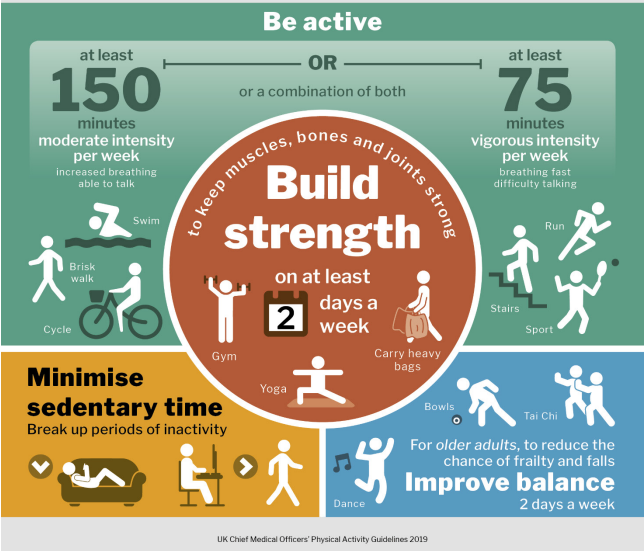Gynaecology: HICO |
D3
|
Physiotherapy
Physical activity and exercises - Physiotherapy
The Physiotherapy team specialise in improving your activity levels and function during treatment and before surgery. Studies have shown that improved function can reduce side effects of treatment, your risk of complications post operatively, the length of stay in hospital and aid faster recovery.
Below is an image showing the Chief Medical Officer's guideline on how much activity we should all be doing in a week. Our aim is to support you to maintain or increase your current activity levels to move towards these guidelines, whilst being cautious of the effects that treatment can have on you and modifying your exercise to accommodate of this. This is done on an individual basis and your physiotherapist will help you to put together an exercise plan.

Recovery after surgery
Here is a video to explain how the physiotherapists will support you to enhance your recovery after surgery.
One area that we like to focus on is strengthening your pelvic floor muscles. These muscles keep your pelvic openings (anus, urethra) closed to prevent incontinence, support the bladder womb and bowels to help prevent prolapse, assist in stabilising the joints of your pelvis, work with the abdominal muscles to support the spine and help with maintaining good posture and help with sexual function.
During surgery, these muscles can becomes stretched and weak. By doing regular pelvic floor exercises before surgery you can lower your risk of developing continence problems after operation (post-op).
The link below will take you to a video which teaches you the pelvic floor exercises:
Pelvic Obstetric and Gynaecological Physiotherapy (POGP) website video
During this project the physiotherapist will record a number of outcome measures, including a sit to stand test, grip strength and short walking test. These will be repeated during the project so we can check on your progress.
We work together with our patients to set achievable and individualised goals and review these on a regular basis.
After your operation we will work with you through the initial stages of your recovery. The aim of this is to get you back to your previous level of function.
Useful information
For help with your pelvic floor exercises please see the following:
Pelvic floor exercises and continence advice for women patient information leaflet
Physiotherapy advice and exercises after gynaecological surgery patient information leaflet
Problems with your bladder or pelvic floor muscles: Self-referral form for physiotherapy
Useful information about pelvic health
Powerbreathe breathing tool video
Contact Us
For University Hospitals Bristol and Weston patients, please contact:
Melissa Brown (Physiotherapist)

